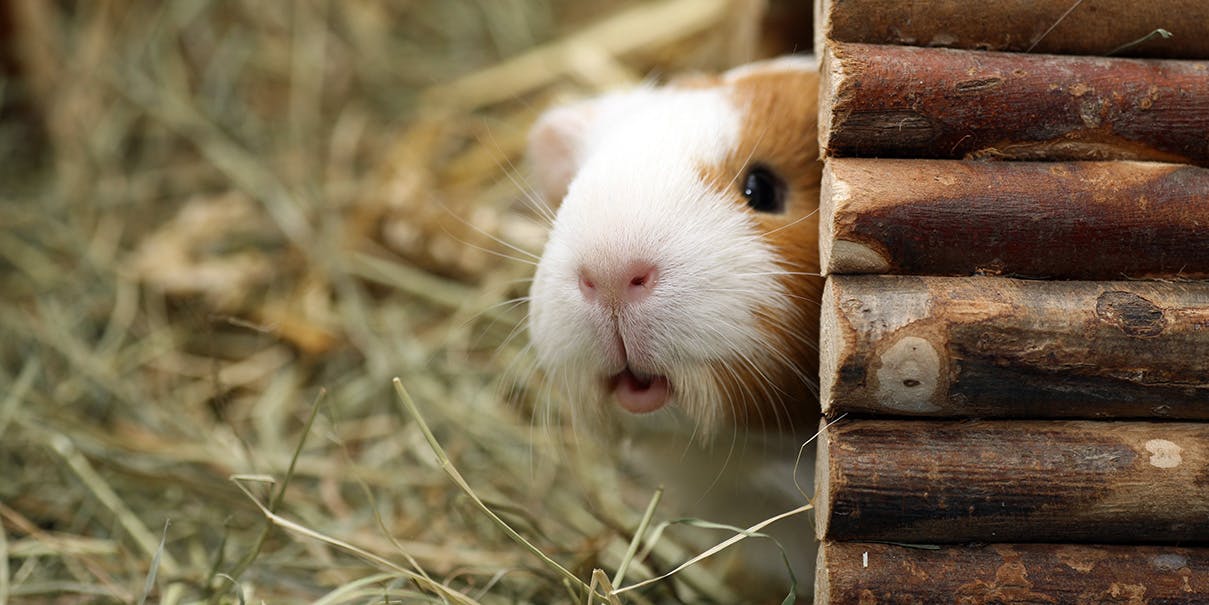
Thinking Of Getting A Guinea Pig? Here's What You Should Know
Small Animals
Adoption
General Advice
01/05/2023
Despite their name, guinea pigs aren’t actually pigs, but are part of the rodent family, just like rats and mice. Also known as ‘cavies’, these cute little critters are easy to care for, gentle natured and make ideal first pets for children. As with all companion animals, they’re entirely dependent on their owners for their daily needs, so even if a child is looking after them, an adult family member must be responsible for their overall safety, health and wellbeing.
Natural selection
If you’ve decided to welcome a guinea pig into your family, there are a few things to consider when selecting your new pet. Look for a guinea pig that’s active and alert, with a clean coat, eyes, nose, ears, mouth and rear end. It’s best to choose a short-haired variety unless you have the time to regularly groom a long-haired animal.
As guinea pigs love the company of their own kind, it’s advisable to house at least two together. Pairs or small groups from the same litter, or a mother/daughter combination usually work best. Two males may fight, especially if introduced later in life, so avoid this grouping if possible. As guinea pigs tend to breed prolifically, it’s important to have them de-sexed if you’re keeping males and females in the same hutch.
My hutch, my castle
Guinea pigs require a spacious, solidly built hutch with an enclosed area for sleeping, as well as a mesh-walled area to provide a light and airy environment for the daytime. The hutch should be cleaned daily to maintain a hygienic and safe home for your pets.
Place the hutch in a quiet, sheltered spot away from predators, on grass that has not been sprayed with pesticides. You’ll need to move the hutch around the lawn so your guinea pigs have access to fresh grass at all times. Guinea pigs like a temperate climate, so avoid exposing them to strong sun during summer. In cold weather, you might like to move them under cover or into a hutch that’s raised off the ground to protect them from the elements. But don’t keep them in the garage, as exhaust fumes can make them ill or could even be fatal.
Clean and warm bedding is vital. Line the floor of their sleeping area with newspaper and untreated wood shavings (available from pet shops) to absorb their urine, followed by a generous top layer of hay or shredded paper for warmth and insulation. Avoid using sawdust, which can irritate their eyes and lungs; artificial fibre bedding, which can cause digestive problems; and wood shavings that have been treated with oils or preservatives, as these may be poisonous to your guinea pig.
Eating like a (guinea) pig
As herbivores, guinea pigs eat a plant-based diet. At all times they should have access to clean drinking water, grass to graze on and an abundant supply of fresh hay. Ideally, hay should be stored in a rack to prevent it from being soiled. Don’t feed mown lawn clippings or grass from roadside areas to your guinea pig as these may have been sprayed with chemicals or soiled by dogs.
Guinea pigs need a daily supply of vitamin C, so give them plenty of fresh vegetables, such as carrots, leafy greens, dandelion greens, broccoli and cabbage. You can offer small amounts of fruit as well, bearing in mind that too much can cause diarrhoea. Good-quality guinea pig pellets supplemented with vitamin C are also available from pet shops. Offer these foods in a heavy bowl that can’t be tipped over or one that can be attached to the side of the hutch.
A guinea’s pig teeth are continuously growing, so they need to eat a variety of hard foods to wear their chompers down and keep them in good condition. As well as providing hay and root vegetables (carrots, turnips, swedes etc.) for this purpose, you may like to buy a gnawing block from a pet shop.
Play it safe
Just like other pets, guinea pigs need plenty of exercise and playtime to keep them healthy and mentally stimulated. You may like to make or purchase a portable exercise pen for them to play and run around in. If you don’t have cats or dogs and you want your guinea pigs to run free indoors, block off any possible escape routes, lay newspaper on the floor to catch any droppings and supervise your pets at all times to prevent them from chewing power or phone cords.
Guinea pigs like to feel secure, so a homemade tunnel from cardboard boxes, cardboard tubes or ceramic piping will go down a treat with your cavy. Alternatively, create a ‘towel tent’ by draping a towel over the corner of your pet’s exercise pen to make a cosy hidey-hole. You could also provide your guinea pigs with ping-pong balls to nudge around. Pet shops sell toys especially for guinea pigs, too – just make sure they don’t have any small parts that could be swallowed or choked on.
Good grooming
Guinea pigs are very clean animals that groom themselves using their front teeth, tongue and back claws. Unlike rats and mice, they don’t smell because they don’t have musk glands. However, it’s still a good idea to give your guinea pig a bath every three months using warm water and a gentle shampoo specially formulated for small animals. Make sure your guinea pig’s fur is completely dry before returning it to its hutch.small pet shampoo
Long-haired guinea pigs need regular, thorough grooming to keep their coats tangle-free and in good condition. You may also need to trim the hair around their rear end from time to time if it becomes soiled or matted. Short-haired breeds can be groomed less often, but bear in mind that regular grooming is a good way to bond with your pet and help it get used to being handled.
Making friends
If you spend time gaining their trust, most guinea pigs will love being gently handled and petted. They can be shy little characters that startle easily, so approach them slowly and quietly from the front to avoid frightening them. Take note of where your guinea pig likes being stroked and petted. Many cavies enjoy being rubbed under their ears or on the back of their neck.
The best way to hold a guinea pig is with one hand under the chest and the other hand supporting its back legs, keeping it close to your body. Hold it securely and carefully, as a fall could seriously injure, or even be fatal to, your pet . Talking softly to your guinea pig should help it remain calm.
If you spend time bonding with your guinea pig and know how to keep it happy and healthy, you’re sure to enjoy being the owner of a pint-sized pet!
Health check
Guinea pigs are generally healthy, robust creatures. To help your guinea pig live a long and happy life, watch out for these potential health problems:
Parasites
If your guinea pig is scratching, has bald spots or irritated skin, it may have become infested with lice from infected hay or straw. This can be treated with a medicated shampoo or powder available from pet shops.
Digestive problems
A lack of roughage – from hay and vegetables – can cause constipation, while some fruits and vegetables or a sudden dietary change may cause diarrhoea. Seek veterinary advice if the problem persists.
Vitamin C deficiency
Guinea pigs need a daily dose of vitamin C and a deficiency may cause scurvy. Prevent this situation by feeding your guinea pig fresh vegetables every day as well as vitamin C-enriched pellets.
Flystrike
This occurs when maggots infest a guinea pig’s rear end and is more common in long-haired breeds and overweight or elderly guinea pigs. This is a serious condition that can quickly become fatal so veterinary attention should be sought immediately.
Respiratory infections
The symptoms are similar to that of the common cold in humans (sneezing, runny nose etc). This can occur if your guinea pig’s environment is too cold or draughty, and can be prevented by keeping your pet in a warm and dry area. Severe cases may develop into pneumonia, in which case you should consult your vet immediately.
NB: This guide only covers some health issues. If you are concerned about your guinea pig’s health, consult your vet for advice.
Fascinating facts
- Guinea pigs originate from South America.
- Dubbed ‘Guinea-zilla’, a now-extinct ancestor of the guinea pig that lived eight million years ago was the size of a buffalo and weighed 700kg!
- Guinea pigs were first domesticated about 5000BC.
- Male guinea pigs are called ‘boars’, females are ‘sows’, and babies are known as ‘pups’.
- There are more than 30 different breeds of guinea pig.
- Guinea pigs squeak, purr, chirp and grunt to express how they are feeling.
- Unlike many other rodents, guinea pigs are born with fur and with their eyes open.
- Guinea pigs have a tail even though you can’t see it.
- Guinea pigs usually live for five to eight years.

Written by The Pet.co.nz
Team
Written by The Pet.co.nz Team
A team of specialists with backgrounds in animal nursing, animal care, and all things pet related.